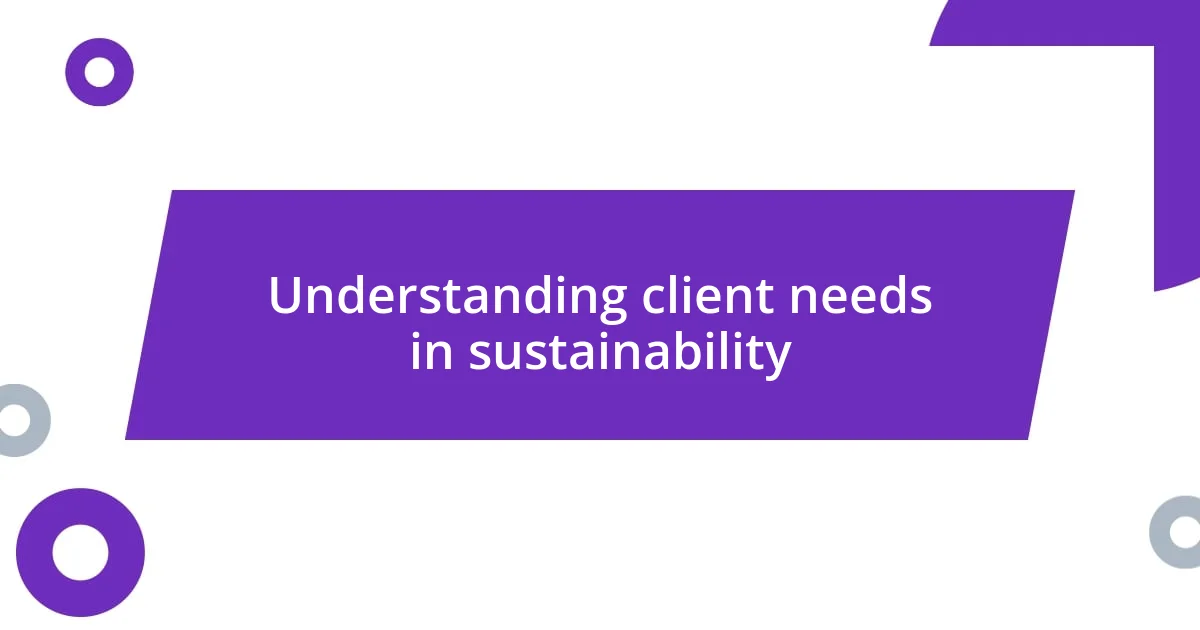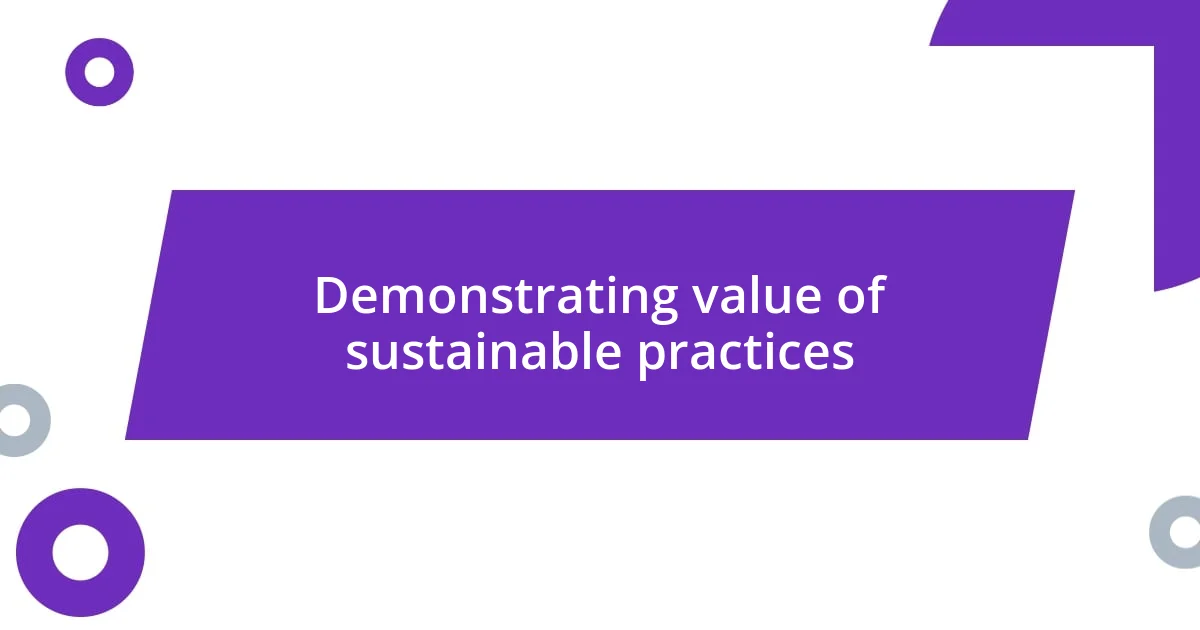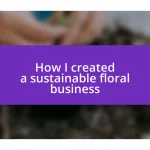Key takeaways:
- Active listening and emotional insights help clarify client priorities and enhance sustainability strategies.
- Transparency fosters trust and engagement, leading to improved community involvement and client empowerment through clear metrics.
- Interactive workshops encourage creativity and collaboration, transforming clients’ perspectives and commitment to sustainability initiatives.

Understanding client needs in sustainability
Understanding client needs in sustainability often starts with active listening. I recall a conversation with a small business owner who was genuinely concerned about their carbon footprint but felt overwhelmed by the information out there. I asked, “What does sustainability mean to you?” That simple question opened up a dialogue that revealed their specific priorities and goals, guiding our strategy together.
Sometimes, I find that clients have a general idea of sustainability but lack clarity regarding what they want to achieve. For instance, a corporate client once expressed a desire to be ‘greener’ but didn’t know where to begin. By probing deeper, I discovered they were passionate about reducing plastic usage but hadn’t considered their energy consumption. This realization created a pathway for us to devise a more tailored approach. Isn’t it fascinating how a few questions can unlock a world of understanding?
Moreover, emotional insights play a crucial role in grasping client needs. I once worked with a nonprofit whose mission was to educate the community on sustainability, but their focus was narrow. After sharing stories of local families impacted by climate change, they shifted their perspective, recognizing the need for broader outreach. It turns out that engaging emotions can be just as vital as data when it comes to paving the way for impactful sustainability initiatives.

Building trust through transparency
Building trust through transparency is vital in creating meaningful relationships with clients. When I first started discussing sustainability with a corporate client, I noticed hesitation when sharing their internal practices. I emphasized the importance of openness, assuring them that disclosing both successes and setbacks would foster a stronger partnership. This transparency not only calmed their fears but also made them more receptive to advice, knowing we were in it together.
In one memorable experience, I collaborated with a nonprofit organization committed to sustainable practices within local communities. They were apprehensive about sharing their struggles with funding and engagement. I suggested that being candid about their challenges could inspire others facing similar issues, potentially attracting support from like-minded partners. Surprisingly, after they shared their journey honestly, they saw an increase in community involvement. It’s a powerful reminder that vulnerability can breed connection and trust.
Moreover, I’ve found that clients appreciate clear metrics and documentation of progress. During a project with a manufacturing company, we initiated a sustainability dashboard that tracked both environmental impact and operational changes. By regularly sharing these insights, the client felt empowered and informed. They expressed that having tangible data not only built their confidence in our strategy but also strengthened their commitment to sustainability. Isn’t it incredible how transparency can transform a business relationship?
| Aspect | Client Response |
|---|---|
| Openness about Practices | Increased receptiveness to advice |
| Candid Sharing of Challenges | Increased community involvement |
| Clear Metrics and Documentation | Empowerment and trust in strategy |

Demonstrating value of sustainable practices
Demonstrating the value of sustainable practices is often about connecting the dots between ethics and measurable results. I remember working with a client whose initial focus was solely on green marketing. As we dug deeper, we uncovered that their energy efficiencies were saving them significant costs—not just enhancing their brand image. When they realized that going green could improve their bottom line while satisfying their moral compass, it was like a lightbulb went off. It’s remarkable how the narrative shifts when clients see financial benefits intertwined with their sustainability efforts.
- Increased efficiency leads to cost savings.
- Enhanced reputation attracts environmentally conscious customers.
- Stronger compliance with regulations can prevent future penalties.
- Long-term investments in sustainability can lead to innovative product lines.
On another occasion, a retail client was curious about incorporating more sustainable materials but feared the costs might outweigh the benefits. As we explored the market, I shared success stories from others who had made the shift. One company not only improved its environmental impact but also saw a dramatic rise in customer loyalty. It resonated with them emotionally; they wanted to contribute positively to the planet. That anecdote transformed their hesitation into a strategic initiative that now defines their brand. It’s these powerful connections that illustrate just how impactful embracing sustainability can be.

Creating tailored sustainability solutions
Creating tailored sustainability solutions starts with truly understanding the unique needs and challenges of each client. I recall working with a mid-sized tech firm that wanted to become more sustainable but felt overwhelmed by the sheer number of strategies available. Instead of advocating for a one-size-fits-all solution, I took the time to listen to their specific goals and constraints. This personalized approach not only led to specific recommendations tailored to their operations, but it also sparked a sense of ownership in the team. Doesn’t it feel rewarding when clients realize they’re part of the solution?
In another situation, I collaborated with a food manufacturer facing sustainability goals yet hesitant about what changes to implement. We held a workshop together, brainstorming options like reducing food waste and enhancing packaging materials. It was amazing to witness their enthusiasm grow as we connected their environmental aspirations with actionable steps. Seeing their faces light up when they discussed how small changes could make a big impact on both their community and the planet reminded me of why I engage in this work. Isn’t it inspiring to be part of that collective “aha” moment?
Moreover, I often emphasize co-creating sustainability roadmaps with clients. Recently, during meetings with a healthcare organization, we mapped out a phased approach to integrating sustainable practices, like energy-efficient equipment and waste reduction strategies. This collaborative method not only shaped an actionable plan but also fostered a deeper commitment from everyone involved. What I found particularly gratifying was how the team began to express pride in their sustainable journey, reinforcing the importance of developing solutions that resonate personally with each client. Doesn’t it feel powerful when everyone rallies around a shared purpose?

Engaging clients with interactive workshops
Engaging clients through interactive workshops has been one of the most rewarding aspects of my work in sustainability. I recall a session where I facilitated a hands-on workshop for a marketing team, focusing on creative strategies for eco-friendly campaigns. As we dove into brainstorming, it was fascinating to witness their energy shift; they not only started to see the potential of sustainability but also how their unique skills could contribute to real change. Doesn’t it just light you up when clients fully embrace the opportunities before them?
Another memorable experience was hosting a workshop on circular economy principles with a group of designers. As we broke into small teams to tackle practical challenges, the atmosphere buzzed with excitement and innovation. One group proposed turning scraps from their production line into fashionable accessories—a solution that sparked laughter and admiration. It was moments like these that made clear how powerful it can be to involve clients in discussions that directly connect to their passions and expertise. How often do we get the chance to blend creativity and sustainability so seamlessly?
What I love most about these interactive workshops is the collaboration that unfolds. I once joined forces with a manufacturing client to build a sustainability action plan during a workshop tailored just for them. By utilizing various interactive tools, such as role-playing and scenario planning, we created a safe space to explore uncertainties. The team ended up crafting actionable steps that they were genuinely excited about! Witnessing that newfound enthusiasm made me realize that engaging clients in this manner doesn’t just elevate their sustainability journey but also fosters stronger relationships. Isn’t it incredible how the right setting can transform skepticism into urgency and commitment?














